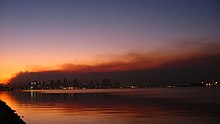October 2007 California wildfires
[17] President George W. Bush concurred, and ordered federal aid to supplement state and local response efforts.[23] Major contributing factors to the extreme fire conditions were drought in Southern California, hot weather, and unusually strong Santa Ana winds, with gusts reaching 85 mph (140 km/h).[24] California's "fire season," which traditionally runs from June to October, has become a year-round threat, due to a mixture of perennial drought and the increasing number of homes built in canyons and on hillsides, surrounded by brush and forest.Volunteers provided food, blankets, water, internet services, children's toys, massages, and a live rock band performance for those at the stadium.To ensure clear roads for emergency vehicles, San Diego mayor Jerry Sanders asked residents to stay home and inside.The four major fires across San Diego County burned over 368,000 acres (1,490 km2) and destroyed or damaged 1,350 homes and 100 businesses since October 21, 2007.[34] On October 24, 2007, the Ammo (Horno) Fire forced the closure of Interstate 5 as well as the Amtrak California Surfliner service between Oceanside and San Clemente.However, many critically endangered animals such as the California condor were moved to the park's veterinary hospital, which is fire-resistant and fully equipped with sprinklers.The fire started in Witch Creek Canyon near Santa Ysabel, and quickly spread to San Diego Country Estates, Ramona, Rancho Bernardo, Poway and Escondido.From there the fire jumped over Interstate 15 and continued west, causing significant damage in Lake Hodges, Del Dios, and Rancho Santa Fe.[52] While many coastal communities were evacuated as the fire moved west, the shifting winds prevented it from directly threatening those areas.[53] On the morning of October 22, at 5:22 AM PDT, residents located between the Del Dios Highway and State Route 56 were ordered to evacuate.[34] On October 24, 2007, the Ammo (Horno) Fire forced the closure of Interstate 5, as well as the Amtrak California Surfliner service between Oceanside and San Clemente.His teenage son suffered burn injuries, along with four firefighters of the California Department of Forestry and Fire Protection, who had attempted to rescue them.[94] The fires occurred at the end of a dry summer and were exacerbated by the seasonal Santa Ana winds, which were blowing at an unusually high strength at that time.The San Diego Union-Tribune reported, "Santa Ana winds blowing up to 60 mph (97 km/h) combined with temperatures into the 90s to create in the worst possible fire conditions.[97] Power outages were reported in Los Angeles, Orange, San Diego, and other counties on October 22 to 333,500 Southern California Edison customers, most being restored within 24 hours.The power outage also affected the areas of Ojai, Oxnard, Simi Valley, Santa Clarita, Thousand Oaks, Agoura Hills, Rialto, Fontana, San Bernardino, Rancho Cucamonga, Mira Loma, Hesperia, Corona, Bloomington, Irvine, Calimesa and Rubidoux.[101] The Navy moved all non-essential personnel from Naval Base San Diego barracks onto nearby vessels to accommodate refugees."[109] March Air Reserve Base was the primary staging area for relief supplies coordinated by the Federal Emergency Management Agency.Besides food, blankets and water, volunteers provided toys for children, massages, and a live rock and roll performance.[20] Six crews from the Navy's Helicopter Sea Combat Squadron 85 based at Naval Air Station North Island were assigned to battle the Witch Creek fire.They flew MH-60 Seahawk helicopters equipped with a 420-gallon water bucket and they were the only local Navy teams trained to fight fires from the air.Marine Corps Air Station Miramar contributed several aircraft as well as fire fighting trucks to operations based in Ramona.[19] One of the larger airtankers, the Martin Mars, sent through a private contract from its home in Port Alberni, British Columbia on October 25, landed on Lake Elsinore in Riverside County, California.[44][116] Rep. Duncan Hunter criticized state fire officials for delaying the use of Marine helicopters until CalFire spotters were in position to coordinate their efforts.

















Southern CaliforniawildfiresSanta Barbara CountyU.S.–Mexico borderfirefighters2007 California wildfire seasonZaca FireArnold Schwarzeneggerstate of emergencyGeorge W. BushUnited States Armed ForcesUnited States National GuardTijuanaTecatedroughtSanta Ana windssemi-truckCal FireLos AngelesCanyonSanta BarbaraHarrisSan DiegoVenturaBuckweedRiversideSantiagoOrangeSan BernardinoPoomachaWitch FireWeather radarSan Diego County2003 Cedar FireReverse 911Carmel ValleySan Diego County SheriffNew Orleans, LouisianaHurricane KatrinaQualcomm StadiumAmerican Red CrossJerry SandersDel MarChula VistaDel Mar HeightsScripps RanchRancho BernardoCalifornia Highway PatrolInterstate 15Interstate 5Amtrak CaliforniaSurflinerOceansideSan ClementeSan Diego Wild Animal ParkCalifornia condorCalifornia Department of Forestry & Fire ProtectionLaguna FireCedar Fire of 2003Santa YsabelSan Diego Country EstatesRamonaEscondidoLake HodgesDel DiosRancho Santa FeCedar FireScripps Ranch neighborhoodMesa Grande Indian ReservationBarona Indian ReservationcasinoJulian, CaliforniaEscondido High SchoolMission Hills High SchoolPoway High SchoolMira Mesa Senior High SchoolDel Mar FairgroundsRancho Peñasquitos4S RanchPalomar MountainPine HillsHarris Firemigrant workersMarine Corps Base Camp PendletonMarine Corps Air Station Camp PendletonLas Pulgas/43 AreaTemeculaAgua Tibia WildernessFallbrookSan MarcosCal State San MarcosAlpineSanta ClaritaAgua DulceCanyon CountryMalibu, CaliforniaSix Flags Magic MountainWest Ranch High SchoolStevenson RanchHighway 14San Fernando RoadSanta Clarita, CaliforniaAngelesLos PadresFillmoreMoorparkVentura CountySantiago FireIrvineOrange CountyGovernorEl Toro High SchoolGreen Valley LakeLake ArrowheadBoy Scouts of AmericaCajon PassCal State San BernardinoLos OlivosSR 371AguangaWildomarMexican stateBaja CaliforniaQuikSCATSouthwestern North American megadroughtThe San Diego Union-Tribune